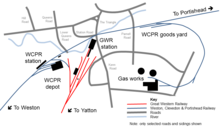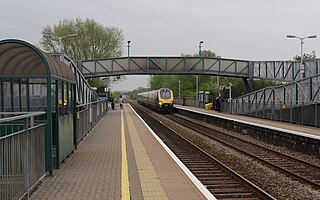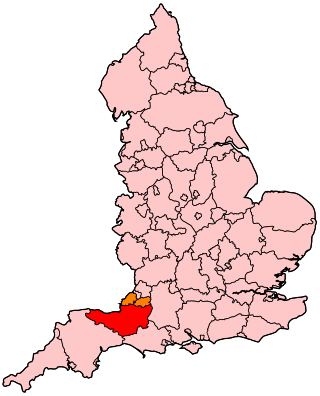
The Clevedon branch line was a 3+1⁄2-mile (5.6 km) branch railway line that ran from Yatton railway station on the Bristol to Taunton Line to Clevedon in North Somerset, England, with no intermediate stops.

The Clevedon branch line was a 3+1⁄2-mile (5.6 km) branch railway line that ran from Yatton railway station on the Bristol to Taunton Line to Clevedon in North Somerset, England, with no intermediate stops.
Seaside resorts became fashionable during the early years of the reign of Queen Victoria. When the Bristol and Exeter Railway (B&ER) opened its main line (at first to Bridgwater) in 1841, a station was provided at "Clevedon Road", about 4 miles (6 km) distant. In the 1845 the B&ER obtained the necessary Parliamentary sanction to open a branch line to the town. [1] The line was opened on 28 July 1847. [1]
Starting from Clevedon Road station, which was renamed Yatton at the same time, it was 3 miles 45 chains (5.73 km) long. Branch trains had a bay platform on the upside with an over-all roof. The line was built to the 7 ft (2,134 mm) broad gauge but converted to the standard 4 ft 8+1⁄2 in (1,435 mm) gauge over the weekend 27 to 29 September 1879. [1] [2]

The branch was mostly operated as a shuttle from Yatton, although there were a few direct trains from Bristol Temple Meads. Between 1924 and 1936 a business service from Bristol at 17:15 consisted of a coach slipped at Yatton, which was then taken to Clevedon on a local train.
Steam railmotors, auto-trains and diesel railcars were used on the line at different times. [2] In its final years, the branch was operated by diesel multiple units or by a single-car diesel railcar. Even in its declining years the service was fairly frequent: the British Railways, Western Region timetable for 1964–1965 shows 24 trains in each direction, with a few more on Saturdays and during the summer, though no Sunday service.

Clevedon station was situated at what is now the Queen's Square shopping and restaurant precinct, built in the 1980s. A set of points are preserved and mounted upright as a reminder of the square's history.
Opened in 1847 it was originally a wooden structure but the single platform terminus was rebuilt in 1890. Clevedon had a signal box until the end of 1916, but from 1 January 1917 the branch was operated "under one engine in steam" arrangements. A ground frame was provided to operate the points in the goods yard at Clevedon which was locked or released by key on the train staff.

Traffic declined as road usage increased in the years following the Second World War. On 10 June 1963 the goods service was discontinued and the goods sidings and ground frame abolished. The station became unstaffed from 20 April 1964, and closed to passengers on 3 October 1966. [3] [4] [5] The line was occasionally used by engineers until about 1970 when the track was lifted. [6]
All the track bed in Clevedon has long since been built on as the town has expanded. The last original bits of track, around Kingston Seymour, were lifted in the late 1980s. Housing developments in the 1990s are built on some of the track bed in Yatton.

Bristol Temple Meads is the oldest and largest railway station in Bristol, England. It is located 118 miles 31 chains away from London Paddington. It is an important transport hub for public transport in the city; there are bus services to many parts of the city and surrounding districts, with a ferry to the city centre. It is the busiest station in South West England. Bristol's other major station, Bristol Parkway, is a more recent station on the northern outskirts of the conurbation.

The Great Western Railway (GWR) was a British railway company that linked London with the southwest, west and West Midlands of England and most of Wales. It was founded in 1833, received its enabling act of Parliament on 31 August 1835 and ran its first trains in 1838 with the initial route completed between London and Bristol in 1841. It was engineered by Isambard Kingdom Brunel, who chose a broad gauge of 7 ft —later slightly widened to 7 ft 1⁄4 in —but, from 1854, a series of amalgamations saw it also operate 4 ft 8+1⁄2 in standard-gauge trains; the last broad-gauge services were operated in 1892.

The West Somerset Railway (WSR) is a 22.75-mile (36.6 km) heritage railway line in Somerset, England. The freehold of the line and stations is owned by Somerset Council. The railway is leased to and operated by West Somerset Railway plc, which is supported and minority-owned by the West Somerset Railway Association (WSRA) charitable trust and the West Somerset Railway Heritage Trust (WSRHT). WSR operates services using both heritage steam and diesel trains.

Yeovil Junction is the busier, but less central, of two railway stations serving the town of Yeovil in Somerset, England; the other is Yeovil Pen Mill. The station is sited 2 miles (3.2 km) outside the town, in the village of Stoford; although Yeovil is in Somerset, the station was in Dorset until 1991. It is located 122 miles 48 chains (197.3 km) down the line from London Waterloo.

The Somerset and Dorset Joint Railway, was an English railway line jointly owned by the Midland Railway (MR) and the London and South Western Railway (LSWR) that grew to connect Bath and Bournemouth, with a branch in Somerset from Evercreech Junction to Burnham-on-Sea and Bridgwater. Strictly speaking, its main line only ran from Bath Junction to Broadstone, as the Bath to Bath Junction section was wholly owned by the MR and the Broadstone to Bournemouth section was owned by the LSWR.

The East Somerset Railway is a 1 mi 63 ch (2.9 km) heritage railway in Somerset, running between Cranmore and Mendip Vale. The railway was once part of the former Cheddar Valley line that ran from Witham to Yatton, meeting the Somerset and Dorset Joint Railway at Wells but was considered for closure even before the publication of 'The Reshaping of British Railways' by Dr Richard Beeching in March 1963.

The Weston, Clevedon and Portishead Light Railway (WC&PR) was a 14.01-mile (22.55 km) standard gauge light railway in Somerset, England. It was conceived as a tramway in the 1880s, opening between the coastal towns of Weston-super-Mare and Clevedon in 1897 and completed to Portishead in 1907. It closed in 1940.

Yatton railway station, on the Bristol to Exeter line, is in the village of Yatton in North Somerset, England. It is 12 miles (19 km) west of Bristol Temple Meads railway station, and 130 miles (209 km) from London Paddington. Its three-letter station code is YAT. It was opened in 1841 by the Bristol and Exeter Railway, and served as a junction station for trains to Clevedon and Cheddar, but these lines closed in the 1960s. The station, which has two platforms, is managed by Great Western Railway, the seventh company to be responsible for the station, and the third franchise since privatisation in 1997. They provide all train services at the station, mainly hourly services between Bristol Parkway and Weston-super-Mare, and between Cardiff Central and Taunton.

Nailsea & Backwell railway station, on the Bristol to Exeter line, is in the village of Backwell, close to the town of Nailsea in North Somerset, England. It is 8 miles (13 km) west of Bristol Temple Meads railway station, and 126 miles (203 km) from London Paddington. The station, opened in 1841 by the Bristol and Exeter Railway, has two platforms but little in the way of facilities. It is managed by Great Western Railway, the seventh company to be responsible for the station, and the third franchise since privatisation in 1997. The company provides all train services at the station, mainly hourly services between Bristol Parkway and Weston-super-Mare, and between Cardiff Central and Taunton.

The Portishead Railway is a branch line railway running from Portishead in North Somerset to the main line immediately west of Bristol, England. It was constructed by the Bristol & Portishead Pier and Railway Company, but it was always operated by its main line neighbour, and was more usually thought of as the Portishead branch or the Portishead railway.

Worle railway station, on the Bristol to Exeter line, serves the Worle, West Wick and St Georges suburbs of Weston-super-Mare in North Somerset, England. It is 16 miles (26 km) west of Bristol Temple Meads railway station, and 134 miles (216 km) from London Paddington. Its three-letter station code is WOR. It was opened in 1990 by British Rail. The station, which has two platforms, is managed by Great Western Railway, the seventh company to be responsible for the station, and the third franchise since privatisation in 1997. They provide all train services at the station, mainly half hourly services between Severn Beach and Weston-super-Mare, and between Cardiff Central and Taunton. The station's car park was significantly expanded in 2013.

The Bristol and Exeter Railway (B&ER) was an English railway company formed to connect Bristol and Exeter. It was built on the broad gauge and its engineer was Isambard Kingdom Brunel. It opened in stages between 1841 and 1844. It was allied with the Great Western Railway (GWR), which built its main line between London and Bristol, and in time formed part of a through route between London and Cornwall.
The Cheddar Valley line was a railway line in Somerset, England, running between Yatton and Witham. It was opened in parts: the first section connecting Shepton Mallet to Witham, later extended to Wells, was built by the East Somerset Railway from 1858. Later the Bristol and Exeter Railway built their branch line from Yatton to Wells, but the two lines were prevented for a time from joining up. Eventually the gap was closed, and the line became a simple through line, operated by the Great Western Railway.
The Wilts, Somerset and Weymouth Railway (WS&WR) was an early railway company in south-western England. It obtained Parliamentary powers in 1845 to build a railway from near Chippenham in Wiltshire, southward to Salisbury and Weymouth in Dorset. It opened the first part of the network but found it impossible to raise further money and sold its line to the Great Western Railway (GWR) in 1850.

The Chard branch lines were two lines serving the town of Chard in Somerset, England. One was a northward branch, opened in 1863, from the Salisbury to Exeter main line, and the other, opened in 1866, ran south-eastwards from the Bristol – Taunton main line. Each branch had its own Chard passenger station at first, although the two lines connected in Chard.

Clifton Bridge railway station is a former railway station in the Bower Ashton district of Bristol, England, near the River Avon. It was opened in 1867 by the Bristol and Portishead Pier and Railway Company as a single platform stop 3.4 miles (5.5 km) along the line from Bristol to Portishead. It was later taken over by the Great Western Railway and had a second platform added.

Pill railway station was a railway station on the Portishead Branch Line, 7.8 miles (12.6 km) west of Bristol Temple Meads, serving the village of Pill in North Somerset, England. The station was opened by the Bristol and Portishead Pier and Railway Company on 18 April 1867. It had two platforms, on either side of a passing loop, with a goods yard and signal box later additions. Services increased until the 1930s, at which point a half-hourly service operated. However the Portishead Branch was recommended for closure by the Beeching report, and the station was closed on 7 September 1964, although the line saw freight traffic until 1981. Regular freight trains through the station began to run again in 2002 when Royal Portbury Dock was connected to the rail network.

The earliest known infrastructure for transport in Somerset is a series of wooden trackways laid across the Somerset Levels, an area of low-lying marshy ground. To the west of this district lies the Bristol Channel, while the other boundaries of the county of Somerset are along chains of hills that were once exploited for their mineral deposits. These natural features have all influenced the evolution of the transport network. Roads and railways either followed the hills, or needed causeways to cross the Levels. Harbours were developed, rivers improved, and linked to sources of traffic by canals. Railways were constructed throughout the area, influenced by the needs of the city of Bristol, which lies just to the north of Somerset, and to link the ports of the far south-west with the rest of England.

The Bristol to Exeter line is a major branch of the Great Western Main Line in the West of England and runs from Bristol, to Exeter, from where it continues as the Exeter to Plymouth line. It was one of the principal routes of the pre-1948 Great Western Railway which were subsequently taken over by the Western Region of British Railways and are now part of the Network Rail system.
The Yeovil–Taunton line was a railway line in England, built by the Bristol and Exeter Railway (B&ER) to connect its main line with the market town of Yeovil in Somerset. It opened in 1853, using the broad gauge of 7 ft 1⁄4 in and was the first railway to serve Yeovil. It ran from a junction at Durston although, in later years, passenger trains on the line ran through to and from Taunton where better main and branch line connections could be made.